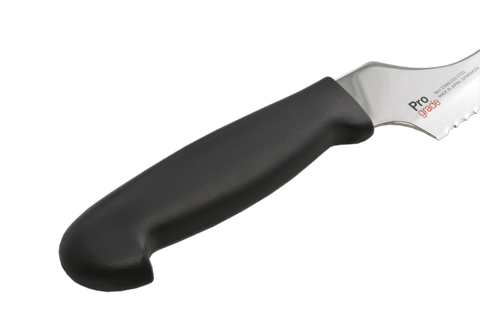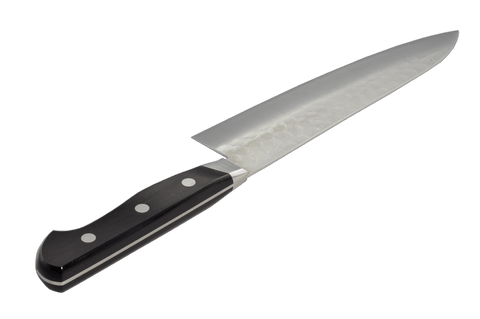GET FREE USA SHIPPING*
GET FREE USA SHIPPING*

Are you still searching for the perfect kitchen knife? At Kakushin, many of our clients inquire about the 'best' option. But what defines the best?
Just like shopping for a car, simply asking for 'the best' might not lead you to the optimal choice. It's crucial to consider your specific needs, usage, and budget. For instance, should I recommend a mini-van for a large family, a pick-up truck for robust use, or an electric vehicle for gas savings? What's best for one might be the worst for another.
In this short blog, I'll delve deeper to help you make the best decision. However, if you're specifically looking for a first and primary chef's knife, check out this video explanation.
On the market, you will commonly encounter two terms used to define knives: western-style knives and Japanese knives. Generally speaking, western knives are ideal for users who need something robust and don't want to spend time giving their knives extra care. These knives are often composed of a full tang, rivets, and commonly shaped handles.
On the other hand, Japanese knives often offer better precision and performance but may lack resistance and can sometimes rust, depending on the type of steel used. Japanese knives are also known to be lighter thanks to their rat tang or narrowing tang. However, it's worth noting that some Japanese knives may feature western-style handles and added weight, despite not being their authentic and traditional look that many seek.
While there are many steel types defined by various composites such as Carbon, Chrome, Vanadium, Sulfur, Manganese, and many others, they are often categorized into two families: Carbon Steel and Stainless Steel.
For a steel to be considered Stainless Steel, amongst other composites, it must contain a minimum of 10.5% chrome. This provides the knife with better resistance to rust and, at times, even better wear resistance depending on the other components. For example, Ginsan, VG10, AUS6-8-10, powdered steel, and more.
On the other hand, for those seeking pure steel, it means mixing iron and carbon, allowing it to take a better edge as the absence of other properties enables the blacksmith to temper the steel to a high Rockwell hardness. The fact that this steel lacks or has low quantities of anti-corrosive properties means it can rust and oxidize easily. However, on the other hand, the sharpenability of pure steel will be much more enjoyable.
Making the choice between various handles can sometimes be overwhelming, and buyers often make a compulsive decision based on aesthetics rather than ergonomic design. With countless factories and blacksmiths constantly designing new models to look unique, ergonomic considerations can sometimes be overlooked.
We've seen handle shapes ranging from square to round, hexagonal to curved, made from materials as diverse as wood, stainless steel, and even rocks. Ultimately, the choice should be based on your application and care level. In commercial environments where time is limited for maintenance tasks like waxing or oiling, PVC and elastomer handles can be excellent alternatives to wood.

In our experience, western-style handles tend to be the most comfortable. While hexagonal handles may have their merits, the proportion of clients who prefer western handles remains much higher in our shop after trying to hold a few styles in their hands.

If you're shopping online and can't physically try out different handle shapes as you would at a reputable retailer like Kakushin, it's wise to opt for a western-style handle. However, hexagonal handles are the second most popular option, followed by various other shapes and styles. I wouldn't recommend purchasing anything other than a western or hexagonal knife handle without trying them first.
Knife shapes and styles often raise questions. Flat profiles? Long blades? Tip-less knives? Choosing the right one can be quite confusing. Exploring the thousands of options on the market could make this task seem never-ending. Let me break down what to consider in your decision.
First, take a look at your current most frequently used knife in the kitchen. While using it, observe your motions and movements, keeping in mind what you typically cook on a daily basis.
This is where knife styles come into play. When cutting, do you primarily use the tip of your knife? If so, consider a knife shape with a pronounced tip, such as the Bunka or Kiritsuke. Do you rock the knife using the entire length of the blade's belly? In that case, a knife with a curved blade, like a Gyuto, might be suitable. Do you prefer to push or pull the knife with direct contact on the board? Then a flat-profile knife like the Nakiri could be a good fit.
It's important to note that the most popular and widely used knives in every kitchen are the Chef's knife and the Utility knife, also known as the Petty.
$10? Or how about $5000? It's important to understand what you're truly buying. Are you purchasing a knife for its performance and usability, or are you acquiring a collector's item? Often likened to a beautifully signed art piece on canvas, the price of a kitchen knife can reflect its reputation and exclusivity rather than just its functionality and aesthetics.
While some may have no price limits, it's essential to recognize that performance will have its boundaries. Let's be honest, a $5000 knife won't necessarily outperform a $500 knife in the eyes of most consumers.
Generally speaking, we find that the best price range for a quality knife, bought from an honest and reputable retailer, falls between $200 and $300 CAD. Will a $100 CAD knife be good? Certainly. Will a $500 CAD knife be better? Likely. However, the best value for your money typically lies within our suggested price range.
In conclusion, just as most of us wouldn't simply buy a car online without consulting an expert to ensure authenticity and suitability for our needs, it's equally essential to make your decision carefully when selecting a quality knife meant to last a lifetime.
Now that we've discussed these factors and are better educated on what to look for, what type of car are you leaning towards: pick-up trucks, electric vehicles, or sports cars 😉?
If you still need assistance, feel free to call us at the shop or send us an email, and we'll help you find the best knife for your needs.
Leave a comment